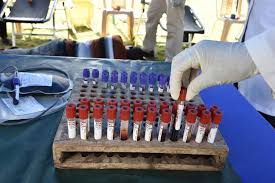Syphilis, often termed a "silent disease," remains one of the most stigmatised Sexually Transmitted Infections (STIs).
This stigma not only isolates patients but also drives them away from seeking essential medical care, perpetuating its spread.
According to Adel Botros, a specialist in dermatology and venereology in Egypt, this stigma manifests in heartbreaking ways.
Recalling a case from a decade ago, Botros recounted how the father of a newborn with congenital syphilis refused treatment due to fear and shame.
According to the World Health Organisation (WHO), syphilis is a preventable and curable bacterial Sexually Transmitted Infection (STI).
If untreated, it can cause serious health issues, though many people with syphilis do not have symptoms or do not notice them.
Syphilis is transmitted during oral, vaginal and anal sex, in pregnancy and through blood transfusion.
Syphilis in pregnancy may lead to stillbirth, newborn death and babies born with syphilis (congenital syphilis).
Correct and consistent use of condoms during sex can prevent syphilis.
Rapid tests can provide results in a few minutes, which allows treatment initiation on the same clinic visit.
Without treatment, the tertiary phase of syphilis may lead to several complications decades after infection.
At this stage, syphilis can affect multiple organs and systems, including the brain, nerves, eyes, liver, heart, blood vessels, bones and joints.
Tertiary syphilis can also cause death.
The global burden of syphilis
According to the United Nations Population Fund (UNFPA), cases of syphilis have increased from 8.8 million in 1990 to 14 million in 2019, with incidence rates rising from 160 to 178 per 100,000 people.
In the United States, rates of congenital syphilis have tripled since 2016.
Despite the global rise in syphilis cases, some regions have shown remarkable progress.
Morocco has significantly reduced congenital syphilis rates, and in 2022, Oman achieved the elimination of mother-to-child transmission of syphilis, according to the World Health Organization (WHO).
These successes underscore the importance of targeted public health initiatives and dispel harmful stereotypes.
Historically, syphilis has been used to marginalize communities, especially women.
In Morocco, during the French colonial period, authorities claimed syphilis prevalence among local women was as high as 80 to 100 per cent.
Research by public health professor Ellen Amster reveals these figures were grossly inflated due to misdiagnoses and unreliable testing.
Actual prevalence was less than 0.5 per cent.
These misconceptions justified oppressive practices, such as confining women to brothels under the guise of controlling syphilis transmission.
“Syphilis was tied to gender disempowerment and shame around sexuality- which always becomes a gendered shame,” Amster explains.
This legacy continues to shape attitudes toward sexual health.
Comprehensive sexual health services, including prevention, education, and counselling are critical.
Experts advocate for breaking the silence around STIs to foster a more inclusive and supportive environment for those affected.
The global rise in syphilis serves as a stark reminder of the importance of integrating human rights into public health strategies.
By addressing stigma and inequality, we can build a future where sexual health is a priority for all.
Modern health crises continue to reveal the enduring intersection of stigma, power dynamics, and public health.
The 2022 Mpox outbreak (formerly known as monkeypox) is a stark example.
Despite efforts by global health authorities to control the virus, stigma persisted, fueled by discriminatory reporting.
According to UNAIDS, media coverage often relied on imagery and language that reinforced homophobic and racist stereotypes, particularly targeting LGBTI and African communities.
Similar patterns were evident during the Covid-19 pandemic, where xenophobic narratives sparked widespread anti-Asian discrimination.
Human Rights Watch documented waves of violence and exclusion driven by unfounded fears about contagion.
Syphilis is no exception to these dynamics. Historically wielded as a tool to marginalise communities, it remains a symbol of shame in many societies.
The WHO notes that the disease disproportionately affects men who have sex with men, further amplifying stigmatization in some communities.
Botros emphasises how fear and shame continue to obscure the true burden of syphilis in regions like the Arab States.
"The stigma weaponised against our region in colonial times persists," he says.
Many patients avoid seeking care unless they have no other option, further complicating efforts to manage the disease.
Towards inclusive and stigma-free health solutions
Addressing contagious diseases requires confronting the prejudices embedded in public health responses.
Experts from UNFPA and WHO argue for the urgent need to engage affected communities rather than alienating them.
This approach not only reduces stigma but also improves disease surveillance and intervention outcomes.
By
prioritising equity, inclusivity, and education, modern society can challenge
the power dynamics that have long obstructed progress in global health,
ensuring no one is left behind in the fight against syphilis and other public
health threats.











